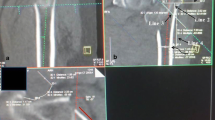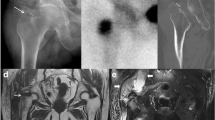Abstract
Purpose
Comparison of conventional radiographs (CR) of distal tibial growth plate fractures [Salter–Harris (SH) fracture types I–V/triplane fractures I–III] with computed tomography (CT) as the reference standard and assessment of diagnostic benefit of CT imaging in the affected patients.
Materials and methods
We retrospectively evaluated all growth plate injuries of the distal tibia with complete pre-therapeutic imaging material (CR and CT including MPR) obtained between August 2001 and December 2006. The imaging material was randomised and presented to two radiologists. Fracture of metaphysis, epiphysis and epiphyseal line were noted separately for distal tibia. In case of fracture, involvement of the articular surface, articular dehiscence and ridge formation, subluxation and number of tibial fragments were evaluated. All fractures were classified as SH type I–V or triplane fractures type I–III. Sensitivity, specificity, positive and negative predictive value and overall accuracy of CR were compared to CT.
Results
Thirty-three patients (mean age 14 ± 2 years) were evaluated. CR showed significantly less tibial fragments as compared to CT (1.39 ± 0.75 vs. 1.61 ± 1.25; p = 0.023). The overall accuracy of CR was <90% for fracture involving the metaphysis (82%), dehiscence of the articular surface (64%), ridge formation of the articular surface (61%) and subluxation (79%). The CR evaluation showed differing SH classification in CT in 10/33 cases (30%) with the highest misclassification rates in type-III SH fracture. For evaluation of triplane fractures, CR classification was incorrect in five cases (71%) out of seven. No misclassification occurred in types I and II SH fractures.
Conclusion
The CR of distal tibial growth plate fractures showed a low overall accuracy for articular surface dehiscence, articular ridge formation and subluxation as compared to CT. CT revealed significantly more fragments. It is difficult to correctly classify type III/IV SH fractures and triplane fractures with CR thus emphasising the necessity of using CT in selected patients.




Similar content being viewed by others
Abbreviations
- CR:
-
Conventional radiograph
- CT:
-
Computed tomography
- MDCT:
-
Multidetector computed tomography
- MPR:
-
Multiplanar reformation
- NPV:
-
Negative predictive value
- PACS:
-
Picture archiving computer system
- PPV:
-
Positive predictive value
- RIS:
-
Radiology information system
- SH:
-
Salter–Harris
References
Peterson CA, Peterson HA (1972) Analysis of the incidence of injuries to the epiphyseal growth plate. J Trauma 12:275–281
Lalonde KA, Letts M (2005) Traumatic growth arrest of the distal tibia: a clinical and radiographic review. Can J Surg 48:143–147
Rohmiller MT, Gaynor TP, Pawelek J, Mubarak SJ (2006) Salter–Harris I and II fractures of the distal tibia: does mechanism of injury relate to premature physeal closure? J Pediatr Orthop 26:322–328
Barmada A, Gaynor T, Mubarak SJ (2003) Premature physeal closure following distal tibia physeal fractures: a new radiographic predictor. J Pediatr Orthop 23:733–739
Mac Nealy GA, Rogers LF, Hernandez R, Poznanski AK (1982) Injuries of the distal tibial epiphysis: systematic radiographic evaluation. AJR 138:683–689
Pesl T, Havranek P (2006) Rare injuries to the distal tibiofibular joint in children. Eur J Pediatr Surg 16:255–259
Brown SD, Kasser JR, Zurakowski D, Jaramillo D (2004) Analysis of 51 tibial triplane fractures using CT with multiplanar reconstruction. AJR 183:1489–1495
McGillion S, Jackson M, Lahoti O (2007) Arthroscopically assisted percutaneous fixation of triplane fracture of the distal tibia. J Pediatr Orthop B 16:313–316
Imade S, Takao M, Nishi H, Uchio Y (2004) Arthroscopy-assisted reduction and percutaneous fixation for triplane fracture of the distal tibia. Arthroscopy 20:e123–e128
Whipple TL, Martin DR, McIntyre LF, Meyers JF (1993) Arthroscopic treatment of triplane fractures of the ankle. Arthroscopy 9:456–463
Cottalorda J, Beranger V, Louahem D, Camilleri JP, Launay F, Dimeglio A, Bourelle S, Jouve JL, Bollini G (2008) Salter–Harris Type III and IV medial malleolar fractures: growth arrest: is it a fate? A retrospective study of 48 cases with open reduction. J Pediatr Orthop 28:652–655
Henckel J, Richards R, Lozhkin K, Harris S, Baena FM, Barrett AR, Cobb JP (2006) Very low-dose computed tomography for planning and outcome measurement in knee replacement. The imperial knee protocol. J Bone Joint Surg Br 88:1513–1518
Jones S, Phillips N, Ali F, Fernandes JA, Flowers MJ, Smith TW (2003) Triplane fractures of the distal tibia requiring open reduction and internal fixation. Pre-operative planning using computed tomography. Injury 34:293–298
Krueger-Franke M, Siebert CH, Pfoerringer W (1992) Sports-related epiphyseal injuries of the lower extremity. An epidemiologic study. J Sports Med Phys Fitness 32:106–111
Jarvis JG, Miyanji F (2001) The complex triplane fracture: ipsilateral tibial shaft and distal triplane fracture. J Trauma 51:714–716
Dailiana ZH, Malizos KN, Zacharis K, Mavrodontidis AN, Shiamishis GA, Soucacos PN (1999) Distal tibial epiphyseal fractures in adolescents. Am J Orthop 28:309–312
Seifert J, Laun R, Paris S, Mutze S, Ekkernkamp A, Ostermann PA (2001) Die Wertigkeit der Magnetresonanztomografie (MRT) bei der Diagnostik von Übergangsfrakturen im Bereich der distalen Tibia. Unfallchirurg 104:524–529
Feldman F, Singson RD, Rosenberg ZS, Berdon WE, Amodio J, Abramson SJ (1987) Distal tibial triplane fractures: diagnosis with CT. Radiology 164:429–435
Karrholm J (1997) The triplane fracture: four years of follow-up of 21 cases and review of the literature. J Pediatr Orthop B 6:91–102
Acknowledgments
Dr. Heyer was supported by official grants of the Bergmannsheil Bochum (Wissenschaftskommission #01-radio-300 and #2007-radio-568).
Author information
Authors and Affiliations
Corresponding author
Additional information
S. P. Lemburg and E. Lilienthal contributed equally to this project as co-authors.
The results of this study are part of the doctorial thesis of E. Lilienthal.
Rights and permissions
About this article
Cite this article
Lemburg, S.P., Lilienthal, E. & Heyer, C.M. Growth plate fractures of the distal tibia: is CT imaging necessary?. Arch Orthop Trauma Surg 130, 1411–1417 (2010). https://doi.org/10.1007/s00402-010-1140-1
Received:
Published:
Issue Date:
DOI: https://doi.org/10.1007/s00402-010-1140-1




